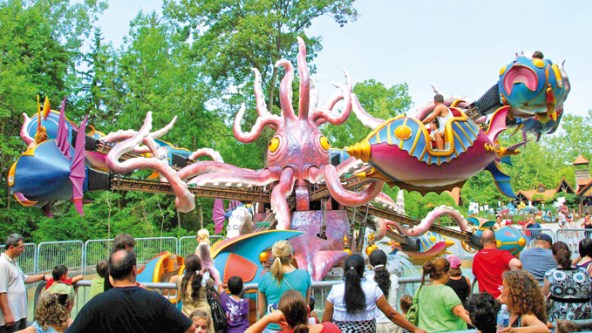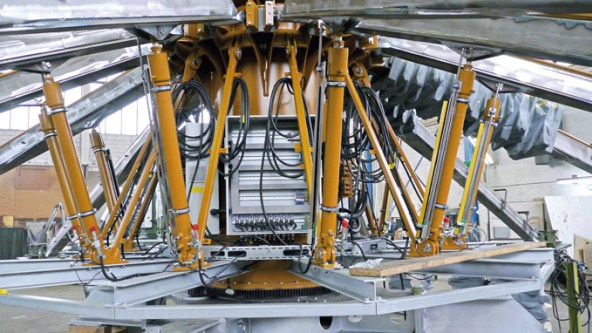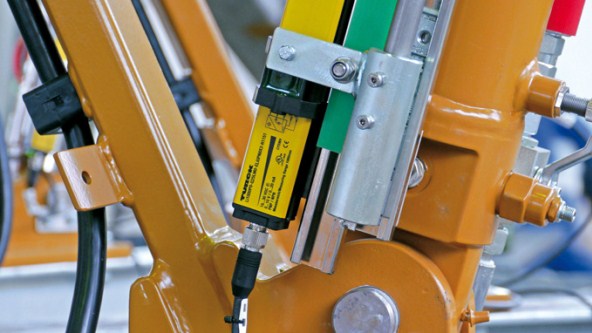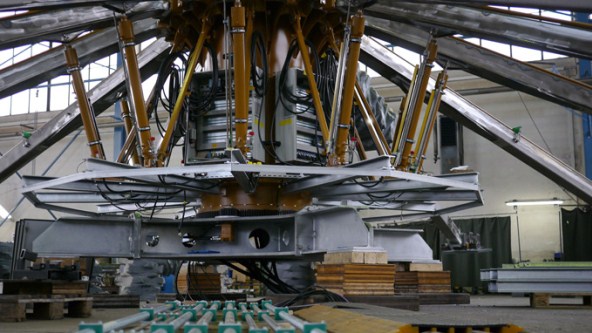Exact Height Positioning
Zierer uses Turck's linear inductive position sensors with IO-Link interface
Amusement rides must not only be enjoyable to their guests, but must also be safe. In this sector, the requirements are often higher than conventional industrial plants. “After all, this ultimately involves passenger transport,” managing director Wolfgang Brück points out. A classic in the Zierer offering is the Flying Fish roundabout ride. With this ride, passengers sit in twelve fish-shaped gondolas. Affixed to metal arms, the gondolas turn around the center of the ride. The twelve fish arranged in a star can be moved up and down hydraulically on their arm.
In order to determine the horizontal position of the arms, Zierer previously used five sensors on each hydraulic lift cylinder. Although this ensured safe operation, the installation of the sensors and their adjustment was relatively complex.
Alternative linear position sensor
A solution using linear position sensing was considered in October 2011. Zierer looked for a linear position sensor that measures the travel of the hydraulic cylinder up to its total length of 1,000 millimeters. Besides testing the sensors of other manufacturers, the Zierer project team also tested the LI-Q25 inductive linear position sensor from Turck.
The LI-Q25 has very short blind zones because the sensing electronics are integrated over the entire length of the sensor. The system is currently the only one of its kind on the market. Zierer was impressed by the test results of the Turck sensor. Even with rapid movements and the resulting centrifugal forces, the sensor reliably supplies the position of the positioning element via the 4…20 mA analog signal. The controller can determine from this the exact position of the arm. Project manager Klaus Gäck summed up as follows: “For us the quality and reliability in the operation is very important. The Turck linear position sensor seems to be the right choice here.”
Parameterization via IO-Link
Despite the positive test, two other requirements had to be clarified afterwards: for safety reasons, Zierer also wanted the possibility to indicate any failure of the positioning element. Although an LED on the sensor indicates if the positioning element is outside of the measuring range, Matthias Niedermeier, in charge of the electrical design, wanted to output this signal on the controller. Here the LI sensor was able to impress thanks to its ability to be parameterized via IO-Link. The IO-Link interface allows the user from the controller to define the measuring ranges, invert the output signal or simply output special signals like the failure signal.
Zierer had another requirement with regard to the MTBF (Meantime Between Failures) values. An analysis in accordance with directive SN 29500 (Ed. 99) has determined that the LI sensor can be operated for 138 years without failure. Managing director Brück was also impressed by the quality: “The sensor not only saves on investment costs but also increases the availability of the ride and contributes to greater operational safety.”
- Automobile
- Mesure d'épaisseur de tôle
- Atelier de presse – Identification d'outils
- Carrosserie – Détection des écrous à souder
- Atelier de peinture – Identification de skids
- Montage final – Montage robotisé
- Montage final – Diagnostic de fuites
- Équipementiers – Système d'identification de pare-chocs
- Protection de zone pour les cellules robotisées
- Mécanique – Vérification sans contact
- Détection des corps dans la production automobile
- Inspection des becs sur des robots de soudure
- Supply of cooling lubricant in machine tools
- Controlling hydraulic pressure in pressing plants
- Measuring process pressure on scissor lifts
- Chargement manuel dans une cellule de soudage
- Détection de pièces noires sur des panneaux de porte noirs
- Détection de verre transparent sur un toit vitré
- Inspection à longue portée dans le secteur de l'assemblage automobile
- Détection de rondelles de caoutchouc sur un bloc moteur
- Détection du positionnement des pièces dans un bloc moteur
- Détection de véhicules électriques aux bornes de recharge
- Détection de voitures dans un car-wash en libre-service
- SUCCESS STORIES
- Modular Conveyor System
- RFID and I/O Modules for Safe Tool Changes
- RFID Guides AGV in Suspension Production
- IO-Link Wired Silencer Production
- Workpiece Carrier Identification in Rear Vent Production
- Weld Nut Sensing
- Traçabilité RFID
- RFID in Engine Production
- Production de pare-chocs avec système d'identification
- Solutions pour ateliers de peinture
- Welding and Assembly Sensors
- Capteurs d'angle pour systèmes d'assemblage
- Identification d'outils
- Système d'aide au choix pour la production de modules de pilotage
- Identification RFID des buses d'injection
- RFID in the Body Shop
- IO-Link Eases Differential Gear Production
- Ply Orientation Inspection
- Chimie
- Détection d'écouvillons
- Systèmes d'E/S déportés pour le traitement de signaux
- Connexion aisée des équipements de terrain
- Télésurveillance des niveaux de cuves avec le DX70
- Traitement des signaux avec un système d'E/S dans l'armoire de commande
- Séparation des signaux avec une technologie d'interface dans une armoire de commande
- Identification de raccords de tuyaux
- Surveillance efficace d'armoires sur le terrain
- Surveillance d'actionneurs quart de tour
- Planification et assemblage de solutions système
- Success Stories
- Gain d'espace dans les salles I&C grâce au système d'E/S excom
- Technologie RFID pour les zones 2 et 22
- Contrôle de test efficace
- Communications de terrain intrinsèquement sûres
- Développement d'un système de contrôle des processus en partenariat
- Système d'E/S déporté pour zones dangereuses
- Dual Valve Position Feedback
- Flexibility with Fieldbus
- Asset Management with Remote I/O
- Positionnement correct avec la technologie RFID dans la production de carbure
- Fast conversion in restricted space
- Energie
- Agro-alimentaire
- Contrôle de la hauteur de la pâte pour une mesure précise
- Contrôle de l'épaisseur de pâte dans des lamineuses
- Détection du bord avant d'une barquette en plastique
- Identification de conteneurs alimentaires
- Vérification de l'exactitude de la date et du code de lot
- Détection de la position d'une vanne
- Vérification de récipients
- Lecture de codes à barres dans un poste de dépalettisation
- Détection de coudes de tuyaux
- Vérification fiable de l'orientation des bouchons dans des espaces aseptisés
- Identification de moules à pralines
- Détection de bouteilles transparentes renversées sur un dépalettiseur
- Détection de bouteilles en plastique transparent
- Inspection d'étiquettes d'emballages alimentaires surgelés
- Accumulation de bouteilles en file indienne sur une aligneuse simple
- Détection de petits pains réfrigérés sur un convoyeur multivoie
- Success Stories
- Track and Trace in Meat Production with RFID
- Contact-free Encoder in Potato Production
- UHF RFID in Food Distribution Center
- RFID for Chocolate production
- E/S distribuées pour l'équipement de production alimentaire
- Remote I/O for Distilleries
- RFID et autoclaves
- IP67 Power Supplies for Conveyors
- Transparency in Chocolate Manufacturing
- Identification in Food Product Storage
- Equipement Mobile
- Surveillance de l'occupation d'un quai de chargement
- Surveillance sans fil de roues de train
- Lignes de distribution pour pulvérisateurs agricoles
- Indication de l'état des reach stackers à l'aide de voyants lumineux intenses
- Mesure d'angle sur un pulvérisateur agricole
- Détermination du positionnement angulaire de la flèche
- Surveillance du sens de déplacement du matériau sur une moissonneuse-batteuse
- Véhicules dans une zone de chargement
- Éclairage de compartiments de rangement des équipements sur des véhicules de pompiers
- Signalisation sans fil pour chariot élévateur
- Mesure de l'inclinaison sur deux axes pour une moissonneuse-batteuse
- Protection contre la collision sur des reach stackers
- Success Stories
- Position Measurement with RFID and Encoder
- Speed Control via Radar Sensor QT50
- La technologie RFID pour guider un chariot autoguidé dans la production de suspensions
- Modules d'E/S sur un super yacht
- Wear-free Encoder on Hopper Dredger
- I/O for Dust Suppression
- Cabinet Cooling
- Quick Disconnect Connectivity
- Automation Solutions for Extreme Cold
- Remote I/O for Cranes
- Rugged Heavy Metal Lifting
- Rollercoaster Positioning
- Mobile Machinery Solutions
- Exact Height Positioning
- Critical Angle Sensing
- Angle Sensor Detects Platform Lift
- Maintenance prédictive des pièces des machines dans une infrastructure de transport du charbon d'un port
- Pétrole et Gaz
- Emballage
- Identification de cartouches d'impression couleur
- Fonctionnement fiable des machines
- Surveillance des bouchons sur des lignes de remplissage
- Surveillance des processus de changement de produits
- Identification de bouteilles de test
- Surveillance du niveau de remplissage de café moulu
- Détection de la notice d'information dans une boîte
- Détection du niveau de remplissage des récipients
- Calcul des dimensions des boîtes en carton
- Détection de bacs de transport
- Détection de barquettes transparentes
- Vérification de la présence d'étiquettes correctes
- Détection de boîtes de différentes tailles sur un convoyeur
- Contrôle des codes à barres 2D à haute vitesse
- Détection d'emballages réfléchissants multicolores
- Mesure de diamètre d'un rouleau de film en plastique
- Positionnement de tubes à l'aide d'un repère
- Solutions pour ensacheuse verticale
- Success Stories
- Pharma
- Comptage de comprimés à haute vitesse avec un amplificateur fibre
- Surveillance d'actionneurs quart de tour
- Détection de coudes de tuyaux
- Systèmes d'E/S déportés
- Planification et construction de superskids
- Détection de liquide dans des poches pour perfusion
- Connexion aisée des équipements de terrain
- Identification de récipients cryogéniques
- Surveillance de niveau de liquide dans une grande cuve
- Identification de contenants en mouvement
- Identification de contenants en mouvement à l'aide de terminaux portables
- Identification de raccords de tuyaux pour des précurseurs
- Identification de raccords de tuyaux dans des zones stériles
- Identification de raccords de tuyaux dans des zones explosives de classe 1
- Identification de big bags et de bioréacteurs
- Identification de produits à usage unique
- Semi-conducteur
- Adhesive Detection on PCB Assembly
- Éclairage d'un outil de production dans le secteur des semi-conducteurs
- Détection du centre de plaques à l'aide du DF-G2
- Great Detail Inspection for Mobile Electronic Devices
- Error Proofing for IC Chips loaded into Pocket Tape
- Presence and Orientation of IC Chips Seated in Nests
- Detection of Hard Disks
- Multiproduct Light-Guided Assembly Station
- Success Stories









